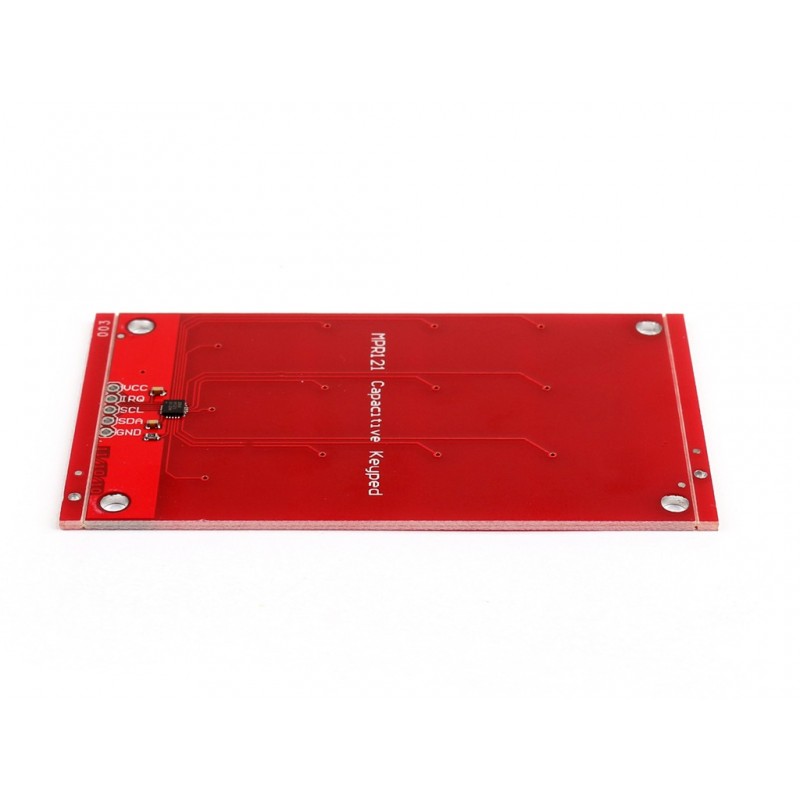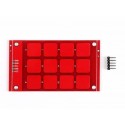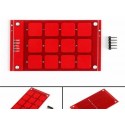Capacitive Switches are great alternative to mechanical buttons. They can be used to build all types of input control buttons of different shapes, sizes and layouts. Use this board to get input from upto 12 different capacitive keys. This chip can handle up to 12 individual touch pads.
This board communicated through I2C, which can be implemented with nearly any microcontroller. Since this is a very popular product, libraries, sample codes, tutorials and guides are available to help you get started and use this board in your project with minimum development time.
This board handles all the low level tasks of calibrating and monitoring the induvidual capacitive input pads and let you focus most of your time on you core project development.
You can select one of 4 addresses with the ADDR pin, for a total of 48 capacitive touch pads on one I2C 2-wire bus. Using this chip is a lot easier than doing the capacitive sensing with analog inputs: it handles all the filtering for you and can be configured for more/less sensitivity.
Capacitive touch is the the technology used on modern touch sensitive devices such as phone and tablet screens, trackpads and computer mice like Apple's Magic Mouse. Capacitive touch takes advantage of the human body being electrically conductive, this is why using a pen on a smart phone doesn't work and styluses for these devices are made of metal so they will make an electrical connection. Capacitive touch is relatively complex to understand but fundamentally the sensor can detect when you are in proximity or actually touching the electrode, or any conductive part between the chip and the end of the wire.
There a four jumpers on the bottom of the board, all of which are set (closed) by default. An address jumper ties the ADD pin to ground, meaning the default I2C address of the chip will be 0x5A. If you need to change the address of the chip (by shorting ADD to a different pin), make sure you open the jumper first. Jumpers also connect SDA, SCL and the interrupt pin to 10k pull-up resistors. If you don’t require the pull-up resistors you can open the jumpers by cutting the trace connecting them.
There is no regulation on the board, so the voltage supplied should be 3.3V or between 2.5 and 3.6VDC.
SPECIFICATION:
Supports upto 12 Input Channels
I2C interface with libraries and sample codes for Arduino, Raspberry Pi and other micro controllers
3.3V Operating Voltage
Low power operation.
1.71 V to 3.6 V supply operation.
29 ?A supply current at 16 ms sampling interval period.
3 ?A Stop mode current.
8 inputs are multifunctional for LED driver and GPIO.
Complete touch detection.
Auto-configuration for each sensing input.
Auto-calibration for each sensing input.
Touch/release threshold and debounce for touch detection.
I2C interface, with Interrupt output.
MPR121: 3 mm x 3 mm x 0.65 mm .
-40°C to +85°C operating temperature range.
OVERVIEW:
-Supports upto 12 Input Channels
-I2C interface with libraries and sample codes for Arduino, Raspberry Pi and other micro controllers
-3.3V Operating Voltage
-Low power operation.
-1.71 V to 3.6 V supply operation.
-29 ?A supply current at 16 ms sampling interval period.
-3 ?A Stop mode current.
-8 inputs are multifunctional for LED driver and GPIO.
-Complete touch detection.
-Auto-configuration for each sensing input.
-Auto-calibration for each sensing input.
-Touch/release threshold and debounce for touch detection.
-I2C interface, with Interrupt output.
-MPR121: 3 mm x 3 mm x 0.65 mm .
--40°C to +85°C operating temperature range.
PACKAGE INCLUDES:
1 PCS x Mpr121 Capacitive Touch Sensor Controller Breakout Board 12 Key
 9962060070
9962060070



